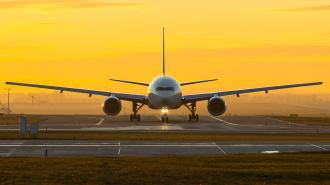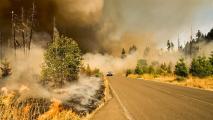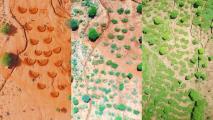The world’s whitest paint is now thin enough to be used on vehicles, meaning it could potentially slash the need for air conditioning in cars, trucks, airplanes, and more.
Hot in here: Higher average temperatures and an increase in the frequency and intensity of heat waves due to climate change are driving demand for air conditioners — the number of AC units worldwide is expected to more than double between 2020 and 2050.
Air conditioning can literally save lives when temps are at their highest, while keeping us comfortable when they’re just annoyingly high. It’s also crucial for transporting goods without overheating.
But air conditioning is already responsible for an estimated 4% of greenhouse gas emissions, and more AC units means more global warming (as well as local warming in cities, since they literally move heat out of cars and buildings into the air).
Ultra-white paint: In 2021, Purdue University researchers unveiled the world’s whitest paint: a substance so white that it reflects 98.1% of sunlight. Surfaces coated in the paint were up to 19F cooler than ambient temperatures, suggesting that it could be used to reduce the need for AC.
“If you were to use this paint to cover a roof area of about 1,000 square feet, we estimate that you could get a cooling power of 10 kilowatts,” said researcher Xiulin Ruan at the time. “That’s more powerful than the central air conditioners used by most houses.”
Air conditioning is responsible for nearly 4% of greenhouse gas emissions.
Unlike air conditioners, which simply move heat from inside to outside, the whitest paint could actually reflect some of this energy back into space, too, helping to directly reverse global warming.
“We’re not moving heat from the surface to the atmosphere,” said researcher Xiangyu Li. “We’re just dumping it all out into the universe, which is an infinite heat sink.”
What’s new? To achieve this cooling effect, the paint needed to be applied in a layer at least 0.4 millimeters (mm) thick. That might not seem like much, but it meant the whitest paint couldn’t be used in the other place we rely on AC: our vehicles.
“[I]n applications that have precise size and weight requirements, the paint needs to be thinner and lighter,” said Ruan.
So the Purdue team went back into the lab and came out with a version of the world’s whitest paint that weighs 80% less and can reflect 97.9% of sunlight, if applied in a layer just 0.15 mm thick.

How it works: A key difference between the new and older versions of the paint is the pigment used — instead of spherical nanoparticles of barium sulfate, a chemical used in photo paper, the team went with hexagonal nanoplatelets of boron nitride, a substance used in lubricants.
“[Computer simulations] showed us that the nanoplatelets are more effective in bouncing back the solar radiation than spherical nanoparticles used in previous cooling paints,” said researcher Ioanna Katsamba.
“An airplane sitting on the tarmac on a hot summer day won’t have to run its air conditioning as hard.”
George Chiu
Incorporating pockets of air into the whitest paint, meanwhile, reduced its density and cut its weight by 80%.
“Now this paint has the potential to cool the exteriors of airplanes, cars, or trains,” said researcher George Chiu. “An airplane sitting on the tarmac on a hot summer day won’t have to run its air conditioning as hard to cool the inside, saving large amounts of energy.”
Looking ahead: It’s not clear how much the paint costs to produce or whether manufacturing could be scaled up easily. However, this product seems destined to find its way out of the lab — Ruan says he’s been fielding calls from architects, spacecraft manufacturers, and more.
“We are in discussions right now to commercialize it,” he said. “There are still a few issues that need to be addressed, but progress is being made.”
We’d love to hear from you! If you have a comment about this article or if you have a tip for a future Freethink story, please email us at tips@freethink.com.






